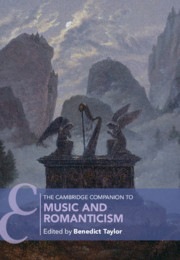Book contents
- The Cambridge Companion to Music and Romanticism
- Cambridge Companions to Music
- The Cambridge Companion to Music and Romanticism
- Copyright page
- Contents
- Figures
- Tables
- Musical Examples
- Contributors
- Preface
- Chronology
- Part I Horizons
- Part II Worlds
- 3 Music and Romantic Literature
- 4 Music, Romantic Landscape, and the Visual
- 5 Romanticism, the Folk, and Musical Nationalisms
- 6 Music, Romanticism, and Politics
- 7 Music and Technology
- 8 Music, Magic, and the Supernatural
- 9 A Kingdom Not of This World: Music, Religion, Art-Religion
- Part III Aesthetics
- Part IV Practices
- Part V Histories
- Select Bibliography
- Index
- References
9 - A Kingdom Not of This World: Music, Religion, Art-Religion
from Part II - Worlds
Published online by Cambridge University Press: 06 August 2021
- The Cambridge Companion to Music and Romanticism
- Cambridge Companions to Music
- The Cambridge Companion to Music and Romanticism
- Copyright page
- Contents
- Figures
- Tables
- Musical Examples
- Contributors
- Preface
- Chronology
- Part I Horizons
- Part II Worlds
- 3 Music and Romantic Literature
- 4 Music, Romantic Landscape, and the Visual
- 5 Romanticism, the Folk, and Musical Nationalisms
- 6 Music, Romanticism, and Politics
- 7 Music and Technology
- 8 Music, Magic, and the Supernatural
- 9 A Kingdom Not of This World: Music, Religion, Art-Religion
- Part III Aesthetics
- Part IV Practices
- Part V Histories
- Select Bibliography
- Index
- References
Summary
The secularisation paradigm, the notion that religion faded into irrelevance in the post-Enlightenment era, has long defined perceptions of Romantic religiosity and religious art. From this perspective, art – in particular, the phenomenon of art-religion – served to fill the void left by the retreat of religion, offering new secularised forms of transcendence to replace those once offered by conventional religious art. This chapter aims to overhaul our received picture by arguing that rather than usurping the place of religion, art-religion serves as its dynamic continuation. It reveals the porous nature of the boundaries between religious art and art-religion in early Romantic thought, examining key texts by Schleiermacher, Wackenroder, and Tieck. It then demonstrates how a similar logic of recuperation and reinvention is at work in Romantic music, drawing on examples ranging from quasi-liturgical music to the monuments of absolute music. The chapter culminates with an exploration of what are arguably the most complex, multilayered examples of Romantic art-religion in the musical sphere, Liszt’s Christus and Wagner’s Parsifal.
- Type
- Chapter
- Information
- The Cambridge Companion to Music and Romanticism , pp. 146 - 162Publisher: Cambridge University PressPrint publication year: 2021

